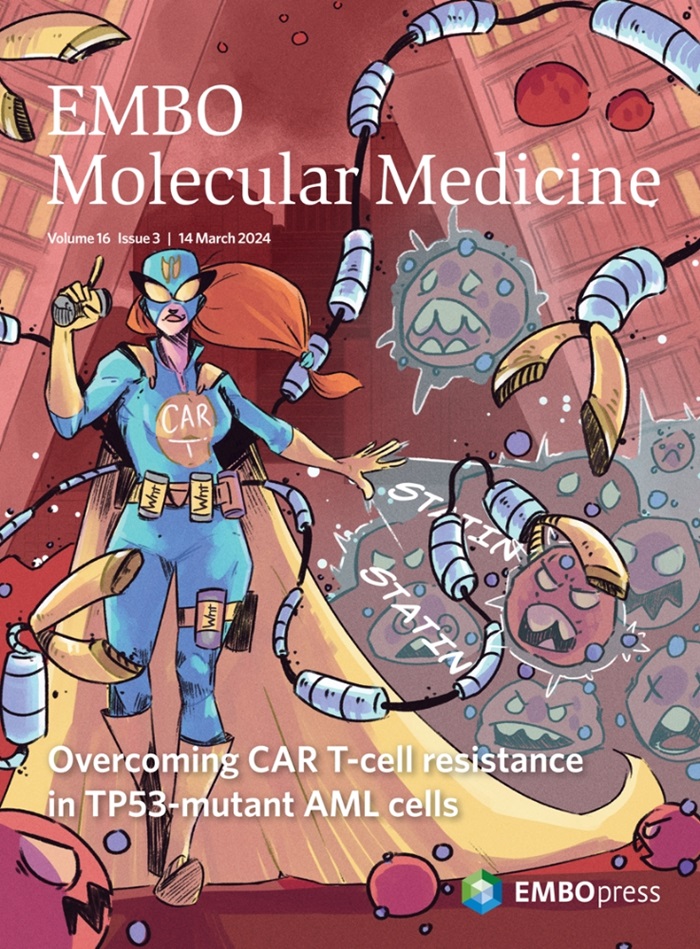Multiomics reveals microbial metabolites as key actors in intestinal fibrosis in Crohn's disease.
IF 9
1区 医学
Q1 MEDICINE, RESEARCH & EXPERIMENTAL
引用次数: 0
Abstract
Intestinal fibrosis is the primary cause of disability in patients with Crohn's disease (CD), yet effective therapeutic strategies are currently lacking. Here, we report a multiomics analysis of gut microbiota and fecal/blood metabolites of 278 CD patients and 28 healthy controls, identifying characteristic alterations in gut microbiota (e.g., Lachnospiraceae, Ruminococcaceae, Muribaculaceae, Saccharimonadales) and metabolites (e.g., L-aspartic acid, glutamine, ethylmethylacetic acid) in moderate-severe intestinal fibrosis. By integrating multiomics data with magnetic resonance enterography features, putative links between microbial metabolites and intestinal fibrosis-associated morphological alterations were established. These potential associations were mediated by specific combinations of amino acids (e.g., L-aspartic acid), primary bile acids, and glutamine. Finally, we provided causal evidence that L-aspartic acid aggravated intestinal fibrosis both in vitro and in vivo. Overall, we offer a biologically plausible explanation for the hypothesis that gut microbiota and its metabolites promote intestinal fibrosis in CD while also identifying potential targets for therapeutic trials.多组学揭示微生物代谢物是克罗恩病肠纤维化的关键因素。
肠纤维化是克罗恩病(CD)患者致残的主要原因,但目前尚缺乏有效的治疗策略。在此,我们报告了对278名克罗恩病患者和28名健康对照者的肠道微生物群和粪便/血液代谢物进行的多组学分析,发现了中重度肠纤维化患者肠道微生物群(如Lachnospiraceae、Ruminococcaceae、Muribaculaceae、Saccharimonadales)和代谢物(如L-天冬氨酸、谷氨酰胺、乙基甲基乙酸)的特征性改变。通过整合多组学数据与磁共振肠造影特征,建立了微生物代谢物与肠纤维化相关形态学改变之间的潜在联系。这些潜在联系由氨基酸(如 L-天门冬氨酸)、初级胆汁酸和谷氨酰胺的特定组合介导。最后,我们提供了 L-天门冬氨酸在体外和体内加重肠纤维化的因果证据。总之,我们为肠道微生物群及其代谢产物促进 CD 肠道纤维化的假说提供了生物学上合理的解释,同时也为治疗试验确定了潜在的靶点。
本文章由计算机程序翻译,如有差异,请以英文原文为准。
求助全文
约1分钟内获得全文
求助全文
来源期刊

EMBO Molecular Medicine
医学-医学:研究与实验
CiteScore
17.70
自引率
0.90%
发文量
105
审稿时长
4-8 weeks
期刊介绍:
EMBO Molecular Medicine is an open access journal in the field of experimental medicine, dedicated to science at the interface between clinical research and basic life sciences. In addition to human data, we welcome original studies performed in cells and/or animals provided they demonstrate human disease relevance.
To enhance and better specify our commitment to precision medicine, we have expanded the scope of EMM and call for contributions in the following fields:
Environmental health and medicine, in particular studies in the field of environmental medicine in its functional and mechanistic aspects (exposome studies, toxicology, biomarkers, modeling, and intervention).
Clinical studies and case reports - Human clinical studies providing decisive clues how to control a given disease (epidemiological, pathophysiological, therapeutic, and vaccine studies). Case reports supporting hypothesis-driven research on the disease.
Biomedical technologies - Studies that present innovative materials, tools, devices, and technologies with direct translational potential and applicability (imaging technologies, drug delivery systems, tissue engineering, and AI)
 求助内容:
求助内容: 应助结果提醒方式:
应助结果提醒方式:


